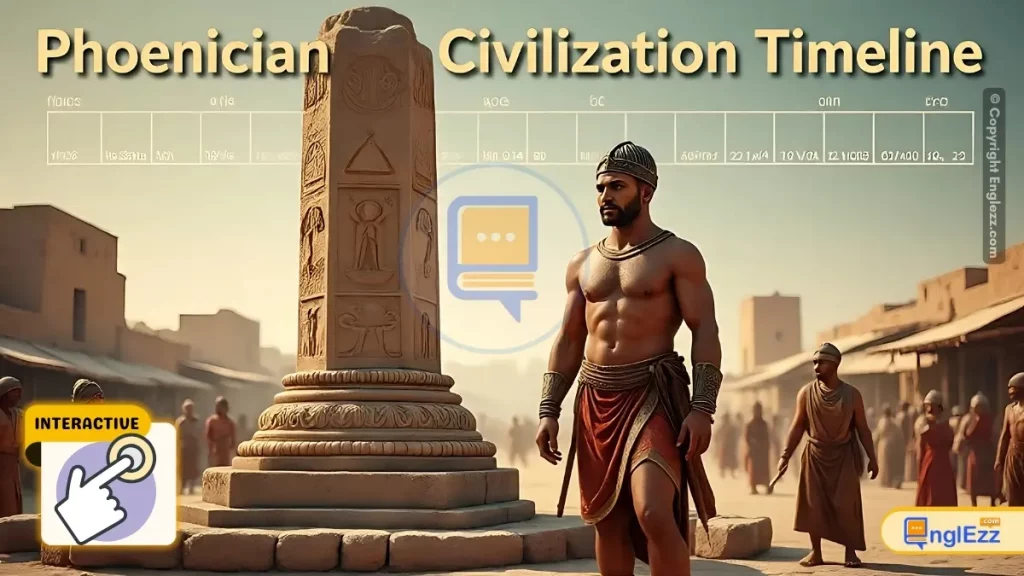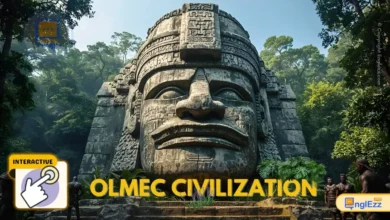
The Story of Phoenician Civilization
Mediterranean Traders and Alphabet Creators (1500-300 BCE)
Introduction
The Phoenician Journey
The Phoenicians were an ancient Semitic-speaking civilization that originated in the Levant region (modern-day Lebanon, Syria, and northern Occupied Palestine). They were renowned as skilled seafarers and traders who established colonies and trading posts across the Mediterranean, spreading their culture and innovations throughout the ancient world.
The Phoenicians excelled at shipbuilding, navigation, dye production (especially Tyrian purple), glassmaking, and most notably, they developed the Phoenician alphabet—the ancestor of most modern alphabets. Their city-states, including Tyre, Sidon, and Byblos, were centers of commerce and culture that connected the ancient Near East with the Mediterranean world.
Early Period (1500-1200 BCE)
The Early Phoenician period saw the emergence of coastal city-states from earlier Canaanite roots. During this time, the Phoenicians began developing their maritime trade networks and distinctive cultural identity. The cities of Byblos, Sidon, and Tyre emerged as important centers of commerce and craftsmanship.
Middle Period (1200-800 BCE)
The Middle period was the golden age of Phoenician civilization, marked by extensive maritime trade, the establishment of colonies across the Mediterranean (including Carthage), and the development of the Phoenician alphabet. This period saw Phoenician traders reach as far as Britain and West Africa, exchanging goods and ideas across the ancient world.
Cultural Legacy
The Phoenicians left an enduring legacy that shaped Western civilization. Their most significant contribution was the development of the first widely-used alphabetic writing system, which evolved into the Greek, Latin, and eventually most modern alphabets. Phoenician trade networks, shipbuilding techniques, and artistic styles also influenced cultures throughout the Mediterranean.
Interactive Phoenician Civilization Timeline
Emergence of Phoenician City-States
The coastal cities of Byblos, Sidon, and Tyre emerge as distinct political and economic centers, developing from earlier Canaanite roots.
Read moreAround 1500 BCE, the coastal cities of the Levant began developing distinct identities as Phoenician city-states. These cities, including Byblos, Sidon, and Tyre, emerged from earlier Canaanite cultural roots but developed unique characteristics through their maritime orientation and trade networks.
Key developments of this period:
- Establishment of independent city-states along the coast
- Early development of maritime trade with Egypt and Mesopotamia
- Specialization in luxury goods like cedar wood, glass, and purple dye
- Cultural exchange with neighboring civilizations
Byblos, the oldest continuously inhabited city in the world, was particularly important during this early period, maintaining close ties with Egypt and serving as a major exporter of cedar wood and papyrus.
Further Reading
- Markoe, Glenn. Phoenicians (2000)
- Aubet, Maria Eugenia. The Phoenicians and the West (2001)
Development of Phoenician Alphabet
The Phoenicians develop the first widely-used alphabetic writing system, simplifying earlier scripts into 22 consonant symbols.
Read moreAround 1200 BCE, the Phoenicians developed their alphabetic writing system, which represented a major advancement over earlier cuneiform and hieroglyphic scripts. The Phoenician alphabet consisted of 22 consonant symbols (no vowels) and was much simpler to learn and use than previous writing systems.
Key features of the Phoenician alphabet:
- First widely-used alphabetic script
- 22 consonant letters (no vowels)
- Written right to left
- Adapted from earlier Proto-Sinaitic and Proto-Canaanite scripts
This revolutionary writing system would later be adapted by the Greeks (who added vowels) and subsequently form the basis for most modern alphabets, including Latin, Cyrillic, Hebrew, and Arabic scripts.
Further Reading
- Healey, John F. The Early Alphabet (1990)
- Powell, Barry B. Writing: Theory and History of the Technology of Civilization (2009)
Foundation of Carthage
Phoenician settlers from Tyre establish the colony of Carthage in North Africa, which would become a major Mediterranean power.
Read moreAccording to tradition, Carthage was founded in 814 BCE by Phoenician colonists from Tyre, led by Queen Dido (Elissa). Located in modern-day Tunisia, Carthage grew to become one of the most powerful cities in the Mediterranean and the center of a vast trading empire.
Key aspects of Carthage’s foundation:
- Strategic location on trade routes between east and west Mediterranean
- Initially a dependency of Tyre but grew increasingly independent
- Developed into a major naval and commercial power
- Later became Rome’s principal rival in the Punic Wars
The foundation of Carthage represents the height of Phoenician colonial expansion, which included settlements in Cyprus, Sicily, Sardinia, Spain, and North Africa.
Further Reading
- Hoyos, Dexter. The Carthaginians (2010)
- Miles, Richard. Carthage Must Be Destroyed (2011)
Phoenician Circumnavigation of Africa
Phoenician sailors complete a circumnavigation of Africa, commissioned by Egyptian pharaoh Necho II.
Read moreAccording to the Greek historian Herodotus, Phoenician sailors accomplished the remarkable feat of circumnavigating Africa around 600 BCE, commissioned by Egyptian pharaoh Necho II. The voyage took three years, with the sailors stopping each autumn to plant crops and wait for harvest before continuing.
Key details of the voyage:
- Sailed clockwise around Africa from the Red Sea to the Mediterranean
- Reported the sun being on their right (northern) side when sailing west—a detail that confirms they passed the southern hemisphere
- Demonstrated Phoenician expertise in navigation and shipbuilding
- Remained unmatched until the Portuguese explorations in the 15th century
While some scholars debate the historicity of this voyage, it stands as a testament to Phoenician maritime capabilities and exploratory spirit.
Further Reading
- Herodotus. The Histories (Book 4.42)
- Cary, M., and E.H. Warmington. The Ancient Explorers (1963)
Fall of Tyre to Nebuchadnezzar II
After a 13-year siege, the Babylonian king Nebuchadnezzar II captures the Phoenician city of Tyre.
Read moreThe Babylonian king Nebuchadnezzar II laid siege to Tyre for 13 years (586-573 BCE) before the city finally submitted to Babylonian rule. This marked the beginning of the decline of Phoenician independence in their homeland, though their colonies (especially Carthage) continued to flourish.
Key aspects of the siege:
- Tyre’s island location made it nearly impregnable to land attacks
- The city withstood the siege through maritime supply lines
- Eventually negotiated terms rather than being conquered by force
- Marked the end of Tyre’s political independence
Despite the fall of Tyre, Phoenician culture and trade networks persisted, and the city remained an important economic center under subsequent empires.
Further Reading
- Katzenstein, H. Jacob. The History of Tyre (1997)
- Wiseman, D.J. Nebuchadrezzar and Babylon (1985)
Alexander’s Siege of Tyre
Alexander the Great conquers Tyre after a seven-month siege, marking the end of Phoenician political independence.
Read moreIn 332 BCE, Alexander the Great laid siege to Tyre during his campaign against the Persian Empire. The siege lasted seven months and was one of Alexander’s most challenging military operations, requiring the construction of a massive causeway to connect the mainland to the island city.
Key aspects of the siege:
- Tyre’s island location presented a major challenge to Alexander’s army
- Alexander built a kilometer-long causeway to reach the city walls
- The Phoenician fleet, initially supporting Persia, eventually defected to Alexander
- After its fall, thousands of Tyrians were killed or enslaved
The conquest of Tyre marked the definitive end of Phoenician political independence in their homeland, though their cultural and commercial influence continued through their colonies, particularly Carthage.
Further Reading
- Green, Peter. Alexander of Macedon (1991)
- Heckel, Waldemar. The Conquests of Alexander the Great (2008)
Spread of the Phoenician Alphabet
The Phoenician alphabet spreads throughout the Mediterranean, evolving into Greek, Latin, and other writing systems.
Read moreThe Phoenician alphabet’s simplicity and efficiency led to its adoption and adaptation by various cultures throughout the Mediterranean world. The Greeks were the first to adapt it, adding vowels around 800 BCE, creating the first true alphabet.
Key developments in the alphabet’s spread:
- Greek adaptation (added vowels) around 800 BCE
- Etruscan and later Latin adaptations
- Aramaic script (derived from Phoenician) becomes dominant in Near East
- Hebrew, Arabic, and other Semitic scripts evolve from Phoenician
- Cyrillic script later develops from Greek
Today, most of the world’s writing systems either descend directly from the Phoenician alphabet or were influenced by it, making it one of the most significant cultural contributions in human history.
Further Reading
- Robinson, Andrew. The Story of Writing (2007)
- Diringer, David. The Alphabet: A Key to the History of Mankind (1968)
Modern Rediscovery
Archaeological excavations begin uncovering Phoenician artifacts and inscriptions, revealing their civilization’s extent and influence.
Read moreBeginning in the 19th century, archaeological excavations at sites like Byblos, Sidon, Tyre, and Carthage began revealing the extent of Phoenician civilization and its influence on the ancient Mediterranean world. Key discoveries included:
- The decipherment of Phoenician inscriptions
- Excavation of Phoenician shipwrecks revealing trade goods
- Discovery of purple dye production facilities
- Uncovering of Phoenician temples and tombs
- Recovery of artifacts showing cultural connections across the Mediterranean
These discoveries helped rehabilitate the Phoenicians’ reputation, which had been negatively portrayed in Greek and Roman sources, and revealed their crucial role as cultural intermediaries in the ancient world.
Further Reading
- Moscati, Sabatino. The World of the Phoenicians (1968)
- Quinn, Josephine Crawley. In Search of the Phoenicians (2017)
Phoenician Civilization Quiz
Test Your Knowledge of Phoenician History
Frequently Asked Questions
Common Questions About Phoenician Civilization
The Phoenician alphabet was revolutionary because:
- It was the first widely-used alphabetic writing system (as opposed to syllabic or logographic systems)
- It consisted of only 22 consonant symbols, making it much simpler to learn than previous writing systems
- It became the ancestor of most modern alphabets, including Greek, Latin, Cyrillic, Hebrew, and Arabic
- Its simplicity facilitated literacy and record-keeping in commercial transactions
- The Greeks adapted it by adding vowel symbols, creating the first true alphabet
This writing innovation fundamentally changed how humans recorded and transmitted information, with impacts that continue to this day.
Phoenician trade networks were among the most extensive in the ancient world, spanning the entire Mediterranean and beyond:
- To the east: Mesopotamia, Persia, and India
- To the south: Egypt and down the Red Sea
- To the west: Across North Africa to Spain and possibly Britain
- To the north: Asia Minor and the Black Sea region
Phoenician traders dealt in luxury goods like Tyrian purple dye, glass, fine textiles, cedar wood, wine, and metalwork. They established trading posts that often grew into full colonies, with Carthage being the most famous example.
Evidence suggests Phoenician traders may have circumnavigated Africa and possibly reached the Americas, though these claims remain controversial.
Tyrian purple was a highly prized dye produced from the murex shellfish:
- Named after the Phoenician city of Tyre, the main production center
- Required thousands of shellfish to produce a small amount of dye
- The color didn’t fade but became brighter with weathering and sunlight
- Associated with royalty and high status in ancient societies
- So valuable that its production was a closely guarded secret
- Became a major source of wealth for Phoenician cities
The dye’s value came from its rarity, vibrant color, and association with power. Roman emperors later restricted its use to the imperial family, reinforcing its status as the “color of kings.”
While the ancient Phoenician civilization no longer exists as a distinct political or cultural entity, their legacy continues in several ways:
- Modern Lebanese people often identify with Phoenician heritage
- Phoenician cultural influences persist in Mediterranean cuisine, traditions, and place names
- The Phoenician alphabet lives on through its descendant writing systems
- Genetic studies show significant Phoenician ancestry in populations around former colonies
- Cultural revival movements in Lebanon emphasize Phoenician roots
While the Phoenicians as a distinct people were gradually assimilated into other cultures (particularly during the Hellenistic and Roman periods), their contributions to world civilization remain fundamental.
Conclusion
The Phoenician Legacy
The Phoenicians were among the most influential civilizations of the ancient Mediterranean world. As master seafarers and traders, they connected diverse cultures and spread innovations across three continents. Their most enduring contribution—the alphabet—revolutionized written communication and became the foundation of most modern writing systems.
Though their political independence ended with Alexander’s conquests, Phoenician cultural and commercial influence persisted through their colonies, particularly Carthage. The Phoenicians demonstrated how a small group of city-states could have an outsized impact on world history through trade, innovation, and cultural exchange.
Phoenician Civilization Key Takeaways
Early Maritime Pioneers
The Phoenicians established themselves as expert navigators and traders, connecting the eastern and western Mediterranean.
Commercial Network
Their extensive trade routes and colonies spread goods, ideas, and technologies across the ancient world.
Cultural Mediators
Phoenicians facilitated cultural exchange between Mesopotamia, Egypt, and the Mediterranean world.
Alphabetic Revolution
Their writing system became the ancestor of most modern alphabets, transforming human communication.
Enduring Influence
Phoenician innovations in shipbuilding, navigation, and manufacturing shaped subsequent civilizations.
The study of Phoenician civilization reminds us of the profound impact that maritime commerce and cultural exchange can have on human development. In an era before mass communication, the Phoenicians connected distant peoples and spread ideas that would shape the course of Western civilization. Their legacy lives on every time we write a letter, read a book, or trace the origins of our interconnected world.
Recommended Reading About Phoenician Civilization
- Markoe, Glenn. Phoenicians (2000)
- Aubet, Maria Eugenia. The Phoenicians and the West (2001)
- Quinn, Josephine Crawley. In Search of the Phoenicians (2017)
- Moscati, Sabatino. The World of the Phoenicians (1968)
- Hoyos, Dexter. The Carthaginians (2010)









